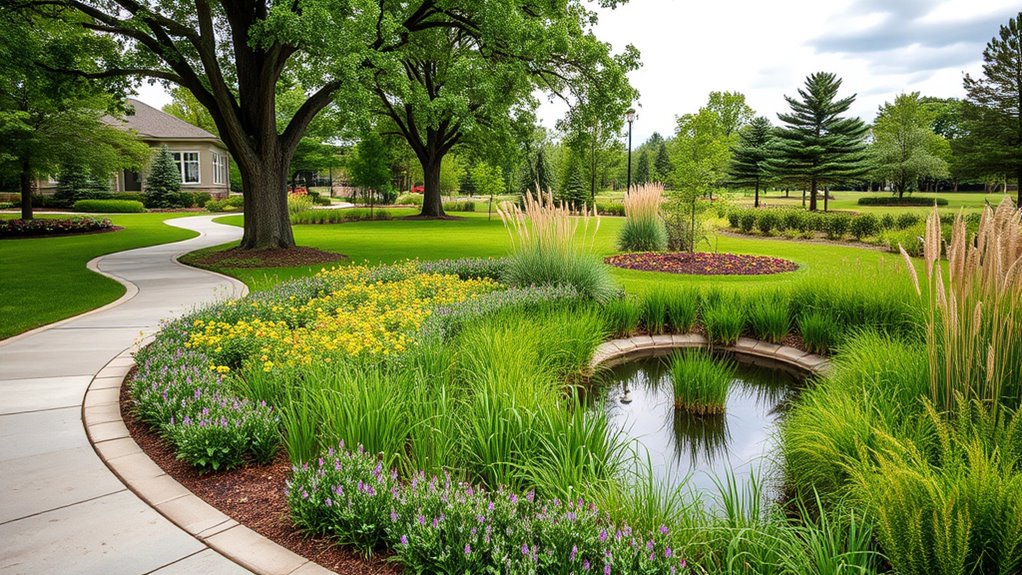Nature-based stormwater management uses natural processes and ecosystems like rain gardens, green roofs, and permeable pavements to absorb, filter, and redirect runoff in urban areas. It helps reduce flooding, lowers pollution levels, and improves water quality by mimicking natural hydrological cycles. Plus, it enhances urban resilience, cools cities, and supports biodiversity. If you want to discover more about how these solutions create healthier, more sustainable communities, keep exploring this approach.
Key Takeaways
- Utilizes natural ecosystems and green infrastructure like rain gardens and permeable pavements to absorb and filter stormwater.
- Mimics natural hydrological cycles to reduce urban flooding and pollutant loads.
- Enhances urban resilience by managing stormwater sustainably and supporting biodiversity.
- Improves water quality by filtering sediments, nutrients, and heavy metals from runoff.
- Offers cost-effective, climate-adaptive solutions that promote healthier, greener cities.

Nature-based stormwater management offers an effective and sustainable way to handle urban flooding and water pollution. By leveraging natural processes and ecosystems, you can reduce the strain on traditional drainage systems and improve water quality. Green infrastructure plays a central role in this approach, integrating elements like rain gardens, green roofs, permeable pavements, and vegetated swales into urban landscapes. These features are designed to mimic natural hydrological cycles, allowing stormwater to be absorbed, filtered, and slowly released back into the environment. Instead of rushing directly into storm drains, urban runoff is intercepted and managed on-site, which minimizes the risk of flooding and decreases pollutant loads reaching water bodies.
Nature-based stormwater management reduces urban flooding and pollution through eco-friendly infrastructure that mimics natural water cycles.
When you implement green infrastructure solutions, you’re creating a more resilient urban environment. For example, rain gardens—shallow, planted depressions—capture runoff from roofs and streets, giving water time to infiltrate the soil and be naturally cleaned by plants and soil microbes. Green roofs, covered with vegetation, absorb rainwater and reduce the volume of runoff that would otherwise overwhelm city drainage systems. Permeable pavements allow water to pass through their surface and into underlying layers, preventing excess runoff during heavy storms. These measures not only manage stormwater more sustainably but also enhance urban aesthetics, improve air quality, and provide habitat for local wildlife.
Urban runoff, which often contains pollutants from vehicles, industrial activities, and improper waste disposal, poses serious environmental challenges. Traditional stormwater systems typically rush this contaminated water directly into rivers and lakes, exacerbating water pollution. By integrating green infrastructure into city planning, you can markedly reduce the amount of pollutants carried by urban runoff. Plants and soil in rain gardens and green roofs act as natural filters, trapping sediments, nutrients, and heavy metals before they reach water bodies. This approach not only improves water quality but also helps in meeting regulatory standards and protecting aquatic ecosystems.
Furthermore, green infrastructure offers long-term benefits that go beyond stormwater management. It can lower urban temperatures, reduce the heat island effect, and promote healthier communities. As you adopt nature-based solutions, you’re making cities more adaptable to climate change impacts, such as increased storm intensity and frequency. Incorporating advanced fraud detection techniques like predictive analytics and geolocation data in urban water systems can further enhance their resilience and security. Overall, embracing green infrastructure to manage urban runoff is a vital step toward creating smarter, more sustainable cities that work in harmony with nature. It’s an investment that pays off by reducing costs associated with flooding, water treatment, and environmental degradation, all while fostering a greener, more resilient urban landscape.
Frequently Asked Questions
How Cost-Effective Is Nature-Based Stormwater Management Compared to Traditional Methods?
You’ll find that nature-based stormwater management is often more cost-effective than traditional methods, especially over time. The cost comparison shows lower initial setup and maintenance costs, and you can tap into diverse funding sources like grants and environmental programs. By choosing green solutions, you not only save money but also enhance local ecosystems, making it a smart, sustainable investment for your community.
What Are the Long-Term Maintenance Requirements for These Systems?
You’ll need to regularly monitor plant survival and sediment removal to guarantee your system functions effectively. Maintenance involves inspecting plant health, replacing dead or unhealthy plants, and removing sediment buildup that can clog the system. While these tasks aren’t daily, they’re essential for long-term success. Proper upkeep helps sustain filtration capacity and ecosystem benefits, making your investment more durable and environmentally friendly over time.
Can Urban Areas Fully Adopt Nature-Based Stormwater Solutions?
Yes, urban areas can fully adopt nature-based stormwater solutions by integrating green infrastructure that promotes urban biodiversity. You can implement rain gardens, green roofs, and permeable pavements to effectively manage runoff. These solutions enhance city resilience, improve air quality, and support local ecosystems. While maintenance is needed, proper planning and community involvement guarantee these systems thrive long-term, making cities more sustainable and environmentally friendly.
How Do Climate Change Impacts Influence These Systems’ Effectiveness?
They say “a chain is only as strong as its weakest link,” and climate change impacts can weaken these systems. You might find that increased rainfall, rising temperatures, and extreme weather reduce climate resilience, challenging ecosystem adaptation. To stay effective, you need to continuously upgrade and diversify your solutions, ensuring they adapt to changing conditions. This way, your stormwater management remains robust, protecting urban areas against climate-induced stresses.
Are There Any Regulatory Barriers to Implementing Nature-Based Solutions?
Yes, you may face regulatory hurdles and policy restrictions when implementing nature-based solutions. These barriers can include complex permitting processes, strict zoning laws, or lack of clear guidelines that delay project approval. To overcome these challenges, you should engage with regulators early, advocate for updated policies supportive of green infrastructure, and collaborate with local authorities to align your project with existing regulations, making approval smoother.
Conclusion
By embracing nature-based stormwater management, you harness the power of natural systems to reduce flooding and improve water quality. It’s like planting seeds for a healthier future, where ecosystems work alongside you instead of against you. When you prioritize these green solutions, you create a resilient environment that adapts and thrives. Together, you and nature can turn stormwater challenges into opportunities—making your community more sustainable and beautiful, one green step at a time.









